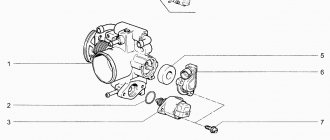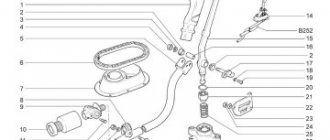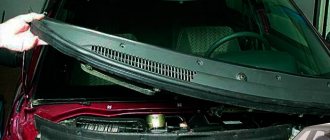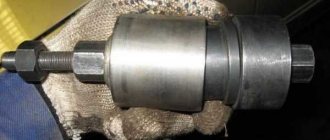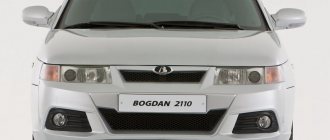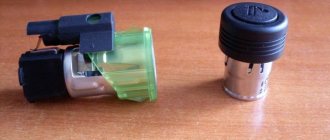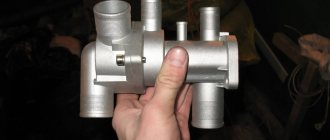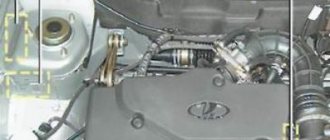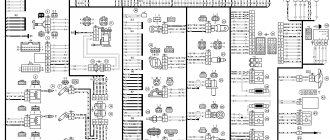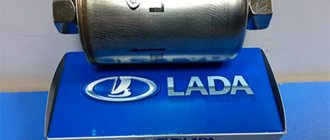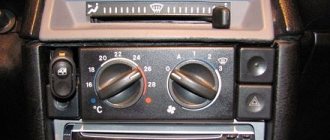MD throttle tuning, myth or not?
| It is believed that the inventor of MD (Modern Throttle) tuning is the American engineer Ron Hutton. According to him, this modification of the throttle assembly allows you to change the state of the air flow (create turbulence), which allows you to increase engine power and reduce fuel consumption by up to 25%. Is it really? |
How to make MD throttle tuning with your own hands
Great accuracy does not play a role here.
The cutting depth should depend on the wall thickness, usually 2-3 mm (no more than 5 mm). To remove any burrs that have formed, you can use fine sandpaper. The process is not complicated and does not require ECU firmware. How to do MD tuning is shown in the video (watch from 8 min 46 sec):
If the tool is powerful enough, the work will not take more than 15 minutes. At service stations they charge from 7,000 rubles for such tuning of the throttle valve.
Reviews about MD tuning
After such modernization of the throttle assembly:
- + The gas pedal becomes more informative (more responsive).
- + Increase in power from 1000 to 3000 rpm.
- + Reduced fuel consumption.
- ─ Loss of elasticity.
To find out whether there is an effect from MD tuning, an experiment was carried out (look at the video above from 12 minutes 30 seconds):
- The car's tank was filled to maximum.
- We drove about 20 km by car.
- We filled the tank to the maximum (consumption was 2.01 liters).
- A modernized throttle assembly (diameter 46 mm) was installed.
- We drove the car along the same section of the road.
- We filled the tank to the maximum (gasoline consumption was 1.61 liters).
Thus, fuel savings amounted to about 20%. In addition, an increase in low-end power was noted.
If, after upgrading the throttle assembly, problems with idle speed appeared, then most likely the tightness of the closed throttle valve was broken (too large recesses were made).
What reviews can you leave about MD tuning?
Pro MD tuning. The essence of technology
Using Gadgetman Technologies LLC technology, recesses and grooves of a certain size and at a certain angle are made near the throttle valve.
You can see the grooves in more detail in the TV channel's story. When the throttle valve moves, the grooves ensure the formation of the necessary oscillations in the air flow. In order for there to be current (movement), a potential difference is needed. In order for there to be wind, a pressure difference is needed. Imagine a pipe. This pipe may be bent. It does not matter. At which end the pressure changes in that direction and the air flow moves. Now imagine that air moves along the entire length of this pipe with a very high oscillation frequency. These vibrations prevent gasoline particles from settling on the surfaces of the combustion chamber. As a result, you get a well-mixed (homogeneous) combustible mixture that burns in the best possible way. This video emulation gives a partial idea of how the grooves work. The video shows the incorrect groove geometry.
These grooves also increase vacuum fluctuations in the combustion chamber. This increases the evaporation of large gasoline particles, which previously simply flew out into the pipe without having time to burn. The author of the technology himself talks about this on the next page “ Author about technology ”.
Some car owners note that the car drives better on 95 gasoline than on 92 gasoline. This is due to the fact that additives are added to the 95th to slow down the combustion of the combustible mixture and reduce detonation. The combustion of the combustible mixture becomes more uniform and smooth. But detonation still occurs. It’s just that such combustion allows you to produce more useful work compared to 92-octane gasoline in the same period of time until the moment when the remnants of the combustible mixture explode, causing detonation. After professional modification of the throttle valve, 92-grade gasoline burns evenly and more energy goes into operation. And it is precisely because of the reduction in detonation that the engine can run quieter and smoother at idle.
Professional tuning of the throttle assembly increases the traction (dynamics, throttle response) of the car at low speeds and reduces gasoline consumption. Economy indicators depend not only on your driving style and the quality of gasoline, but also on the characteristics of the car’s fuel system.
Pro MD tuning is:
- Increased car traction at low speeds;
- Disappearance of speed dips during acceleration;
- Improving vehicle response;
- Sensitivity to on disappears. air conditioner;
- Minicars with incl. air conditioning starts to drive;
- Thoughtfulness disappears when accelerating;
- Cars with automatic transmission, as a rule, stop stalling;
- Overcoming climbs in high gear;
- There is no need to downshift when overtaking;
- Reducing speed in different gears;
- The appearance of rolling; (see page “Misconception”)
- More driving pleasure.
Increased engine elasticity;
In 90% of cases, the effect does not appear immediately. You need to drive an average of 250 km for the ECU to retrain on a car with an injection engine. Therefore, a guarantee is given to return the unit to its original condition and return money if the result is not satisfactory. The disadvantages include changing the habit of pressing the gas pedal (accelerator). You will need to learn not to put too much pressure on the gas, since the car already drives fine, regardless of whether you press on the gas or not. Retraining takes from 15 minutes. As an example, look at how a regular stock Chevrolet Niva drives at idle speed after Pro MD tuning.
Your browser does not support video. Please use another browser.
Throttle tuning does not require attention or maintenance. The service is provided using special equipment based on a license agreement and OGRN certificate 309165033700078.
* If you are afraid of this technical solution to increase Power and reduce fuel consumption, then you can use other technical solutions.
See section " Special" technologies ":
- Spark plug;
- Specialist. treatment;
- Nanocarbon.
Cleaning the throttle valve of a VAZ 2114
There are two cleaning methods: - Without removing the unit; — And accordingly with its dismantling.
Which method should I choose? It all depends on the degree of pollution. If the mileage has been up to 25 thousand since cleaning or replacing the throttle. Then, most likely, it is possible to limit ourselves to superficial cleaning and prevention without removing the part. In other cases, it is recommended to completely dismantle the unit for deep, thorough processing, cleaning and gaining access to hard-to-reach places.
We will describe in detail the process of complete removal after which the first option will not be difficult to complete. So, let's begin:
To begin, unscrew the cap of the expansion tank with antifreeze. This is necessary in order to “relieve” the pressure and avoid antifreeze leaking out of the hoses.
Next, we need to unscrew and loosen all the clamps that tighten the hoses attached to the throttle block. The same applies to the air pipe. To carry out the work, we will need a 13mm wrench or socket. After removing the clamps, we disconnect the hoses themselves. We disconnect the pipe from only one side and, for convenience, move it to the side.
Now remove the throttle cable from the throttle drive selector.
Turn off the power to the sensors.
Take the 13mm head, unscrew the two bolts and remove the throttle assembly. Remove the old gasket.
To treat contamination, you can use carburetor cleaner and a clean rag or rag. If the degree of contamination is very high, then you can use a toothbrush with hard bristles. Just before cleaning, disconnect the idle air control. Apply the product to the contaminated surface. Using progressive movements, remove carbon deposits from the metal surface. If you are not satisfied with the result, repeat the operation again until complete cleansing
It is very important to clean or blow out the channels that are in the product. A lot of dirt accumulates there
It is most convenient to carry out purging using compressed air. To do this, you can use a regular car pump. If the sensor socket and the sensor are clogged, be sure to clean them too. Do not forget to carefully clean the junction of the throttle assembly and its internal cavity. To do this, apply some cleaning product to a rag. Distribute evenly on the inner walls of the parts. Take a brush and clean the problem areas. After finishing the treatment, wipe the cleaned areas with a damp cloth and remove any remaining dirt. After washing the unit, it is recommended to clean and blow out the disconnected pipes. We expect a short amount of time. We install a new gasket at the junction of the throttle assembly. We attach and secure the knot in place. We connect the IAC sensor. We pull the hoses onto the fittings of the cooling system and connections to the adsorber. We put on the throttle body pipe. We fix the cable on the drive. Tighten the clamps of all attached elements. We connect the sensor chips. Close the cap of the expansion tank with coolant. We start the car and test its operation.
Cleaning the throttle valve VAZ 2114, 2115, 2110
The non-removal method is somewhat similar to the one we described earlier. The only difference is that we will only remove the air duct pipe and nothing else. The work steps are as follows: — Remove the pipe; — We repeat point number 10 of the previous method. — We connect and secure everything in the reverse order, not forgetting to replace the old gasket with a new one.
Keep in mind that this method is most suitable for preventative, light, superficial cleaning. If malfunctions or incorrect operation of the engine occur, use only the removal method. Now we know how to clean the throttle valve on a VAZ 2114 using two different methods, quickly and without much difficulty.
Helpful advice
Please note that if you do not have a carburetor cleaner available, you can use other cleaning products, for example the well-known WD-40
REMOVING THE THROTTLE VALVE
Before removing the throttle valve on the VAZ 2114, let's remember where this remote control is located on the car.
Why the damper is removed should already be clear that this is necessary to clean it and, if necessary, to replace damaged parts.
To perform this operation you need to prepare the following tools:
- Set of Phillips screwdrivers;
- Socket wrench set to “13”;
- Liquid used to flush carburetors, or similar.
If all this is present, proceed to removal. Let's talk in more detail about how to remove the throttle valve. To do this, you have to do the following:
It is necessary to provide access to the engine compartment, that is, you need to lift the hood of the car; Disconnect the terminals from the battery; It is necessary to relieve excess pressure in the engine cooling system. To do this, just open the cap of the expansion tank; The next step is to remove the plastic cover that covers the top of the motor (if there is one); Now you have to remove the hose for forced ventilation
Don’t forget to inspect it too; if it contains oil residues, it must also be cleaned;
Next, the driver will have to disconnect all connectors from the remote sensing sensors and remove the inlet pipe; The next operation must be carried out carefully and carefully, since the remote control cooling pipe will have to be removed. It is necessary to prepare plugs in advance and close the coolant flow path with them;
Remove the damper drive; At the last stage, remove the nuts that secure the remote control and remove it.
The removed mechanism is in your hands; all that remains is to clean it and put it back in its place.
How to check and replace TPS?
The VAZ throttle position sensor (TPS) is part of the engine throttle assembly. Therefore, when checking the TPS, check the IAC at the same time (see the article How to check the IAC (Idling Air Sensor)?. Because in certain situations they have similar symptoms of a malfunction:
- uneven idle speed;
- Unstable engine operation (the engine stalls after releasing the gas);
- no idle speed;
- the car moves jerkily when the gas pedal is pressed at a certain level;
- low vehicle dynamics (in addition to a malfunction of the sensor itself, low engine dynamics can be the result of many reasons:
- low compression in the engine (How to measure engine compression correctly?);
- wear of the camshaft cams. or incorrectly aligned timing belt marks;
- cylinder head valves are leaking or burnt out;
- the engine power supply system is faulty;
- the air filter is dirty;
- brake cylinders jam;
- the clutch slips;
- the fuel filter is clogged;
- exhaust system is faulty).
It is worth noting that this sensor is not available on new samara-2 models due to the use of an electronic gas pedal.
How to check TPS?
To check the throttle position sensor, we will need the following tools: a multimeter (ohmmeter, voltmeter), pieces of wire.
- Having opened the hood, we find the sensor we need (we look for it on the throttle assembly next to the IAC).
- Disconnect the wire block from the sensor.
- Take a multimeter and set it to voltmeter mode. Volts negative terminal (on the engine). We connect the positive terminal of the voltmeter to the sensor wire block to terminal “A” (the pin numbering is indicated on this wire block).
- Turn on the ignition and check the voltage: the voltmeter should show a voltage of around 5 volts. If the voltage is not supplied, or it is much lower than 5 volts, then the problem is either an open circuit or a malfunction in the electronic engine control system (in the brains). But if the voltage is normal, then, accordingly, the TPS is faulty.
Conclusion: If the sensor is faulty, then there are two options to solve the problem:
- Repair the sensor (How to repair the TPS?). Most often it is easier to replace the sensor with a new one, because The cause of failure is most often normal wear of the part.
- Replace the sensor with a new one.
How to replace TPS?
To replace the throttle position sensor we will need:
- Unscrew the 2 screws securing the sensor to the throttle assembly (see picture).
- Remove the sensor from the damper axis.
- We install the new sensor on the damper axis so that its leads are directed towards the partition of the engine compartment.
- Rotate the sensor relative to its axis until the mounting holes align.
- We wrap the sensor.
- We regulate TPS.
- We connect the sensor contacts.
- Reset the battery terminals for 5 minutes.
How to adjust TPS?
We open the damper by turning the sensor drive sector or pulling the accelerator cable. If this operation fails, the sensor is not installed correctly. In this case, you need to remove the sensor and reinstall it at an angle of 90 degrees relative to the damper axis.
As for manual adjustment of the damper position, the sensor is not adjustable.
The controller automatically uses the sensor's low idle voltage as a reference point. But it happens that after replacing the sensor, the controller uses the values for the old sensor, which causes the throttle valve to open a few degrees. In this case, you need to reset the controller parameters either through the on-board computer or remove the battery terminal for 5 minutes.
Electronic throttle valve: how does it work and how to repair it?
The trend in automotive engineering in recent years has been the systematic removal of the driver from direct control of the car. So far, thank God, we have not reached the point of losing the rigid connection of our arms and legs with the turning wheels and brakes, but everything is clearly heading that way... At least, not a single car these days is produced without an electronic throttle, with which we We do not give a direct command to the throttle “more air!” with the right foot through the cable, and express a wish to the engine control unit, which itself sends a command to the damper. Is this good or bad, and how to live with it?
Background
It is generally accepted that the so-called E-gas is a technology of the last decade or so. In its pure form - yes, but the integrated electric drive in throttle valves appeared much earlier - back in the 80s. In those years, on the damper axis, on one side there was a gas sector connected to the accelerator pedal with a classic cable (yes, the “wheel” that is driven by a cable from the pedal is called the “gas sector”!), and on the other side, the damper axis connected through a gear transmission to a small electric motor.
Actually, the motor had no influence on the behavior of the car when moving - the connection with the driver’s foot was old-school, mechanical and clear: as you press, so will you go! And the electric motor started working only in idle mode, adjusting the speed of the damper slightly during warming up and after warming up, and also slightly adding gas when turning on powerful consumers of electricity and torque - air conditioning in the summer, power steering in the cold, various heating systems, etc. A little later, the functions of the motor in the throttle expanded - with an almost unchanged design, electronic commands were added: it began to control not only idle speed, but also speed while driving - when the cruise control is turned on and when the traction control system is activated.
Now everything has reached the “apophygea of technology” - the mechanical connection between the damper and the gas pedal has disappeared in principle, and all commands - both from the driver’s foot and from service systems - are received by the throttle only through the mediation of the engine control unit. There are three reasons for this:
- Environmental requirements;
- Increased fuel economy;
- Convenient implementation of many modern car functions.
Electronic throttle these days
So, the direct connection between the throttle valve and the pedal has been completely and completely abolished. As I already said, by pressing the pedal we send a signal to the control unit, which in turn analyzes the situation and many parameters, and then issues a command to supply air. At the same time, it must be said that over a good ten years of development of the tandem of an electronic gas pedal and an electronic throttle in its modern understanding, the system has successfully outgrown a number of childhood diseases - both purely physical and software.
Wearing sliding contacts of damper position sensors have been replaced by non-contact inductive coupling, and many new functions have appeared - not so obvious as to take a line in the technical description of the car, but quite important in the complex.
For example, the gas pedal travel has become non-linear, which makes it possible to better control the car when starting to move: with a powerful engine (where the damper has a large diameter), the risk of excessively rushing forward when lightly touching the pedal has disappeared - the electronic throttle reacts deliberately sluggishly in the first quarter of the gas pedal travel .
E-gas allows for the most optimal acceleration in a car with a turbocharged engine, significantly combating turbo lag and providing smoother acceleration from the bottom. E-gas will also help in the “pedal to the floor” mode, when in the case of a classic cable damper, the first moments of non-optimal combustion of the mixture occur, and seconds are lost during acceleration. Of course, we cannot fail to mention the effective automatic engine traction control system to combat drift and slippage of the drive wheels .
However, it should be noted that the behavior of the electronic throttle on budget cars is still seriously different from mid-price and, especially, premium cars. In “budget” cars, E-gas, unfortunately, is too dull, thoughtful and does not contribute to getting true pleasure from the drive.
Moreover, sometimes it has a negative impact on safety - a throttle with suboptimal control software reacts to pedal pressure with a delay, delivering torque to the wheels when it is already too late. In the absence of stabilization systems in winter on slippery surfaces and when turning, such a car reaction can negate your traditional winter driving skills and create an emergency situation.
The simplicity and complexity of electronic throttle
Typically, the introduction of electronics is accompanied by incredible complication of the design. In the case of the throttle, everything is exactly the opposite! Having carefully studied it, you will find that it is incredibly simple and devoid of a number of tricky technical solutions that were previously available in classic cable-driven chokes. And the good old two-chamber carburetor, compared to the E-choke, is the most complex and expensive device of the steampunk era to produce...
Firstly, of course, the E-throttle does not need an idle air regulator - an air supply valve through a thin channel controlled by a stepper motor, which is prone to contamination by crankcase gases and unstable operation. In the case of an electronic throttle, the idle speed control valve disappears - idle speed is ensured by slightly opening the main damper - after all, it is already electrically controlled, and therefore copes well with adjusting the speed, adapting to the switched on consumers, the temperature of the outside air and antifreeze, etc.
Even the idle system with a classic throttle often included additional bypass air channels that bypassed the damper, which were also very prone to clogging. These channels did not open smoothly, but according to the “on/off” principle, using external electric valves - for example, to compensate for the load on the engine when the air conditioner was turned on. In the electronic throttle, all this also turned out to be unnecessary - compensation for the drop in speed is again done by the throttle valve itself.
Reviews about MD throttle tuning
Advantages of MD tuning:
- The gas pedal becomes more informative (more responsive).
- Increase in power in the range from 1000 to 3000 rpm.
- Reduced fuel consumption.
Disadvantage of MD tuning:
- Loss of elasticity.
1.
Checking the effectiveness of MD tuning in practice (cable):
- The gas tank was filled to maximum.
- We drove about 20 km.
- Once again we filled the tank to the maximum and got a consumption of 2.01 liters.
- We did MD tuning on a throttle body with a diameter of 46 mm.
- We drove along the same section of the road.
- We filled the tank to the maximum (gasoline consumption was 1.61 liters).
Thus, fuel savings after modification of the throttle assembly amounted to about 20%. During the experiment, an increase in low-end power was noted. Watch the experience in the video above from 12 min 30 sec.
2.
Testing the effectiveness of MD tuning in practice (E-Gas):
A similar experiment was carried out on a car with E-Gas. Fuel economy in this case was about 9% (was 1.5 liters, now 1.37). There is a faster response to the gas pedal. See also how to adjust E-Gas.
ps If after MD tuning there are problems with idle speed, then most likely the tightness of the closed throttle valve was broken (the chamfers were made too deep).
Have you modified your car this way? What feedback can you leave about MD tuning?
Let us remind you that we previously talked about other modifications that can improve engine performance. For example, installing a PCV valve in the crankcase ventilation system, as well as installing capacitors in the car’s ignition system.
Practice. Effect
Unfortunately, I myself forgot to measure the acceleration “before and after”. But on the well-known YouTube site I found a video of one guy who was just doing this procedure. At first he had a completely stock VAZ-2112 coupe. Acceleration from zero to 100 km/h was around 11.9 seconds. Then he installed a larger throttle (56mm) and it turned out that the acceleration from 0 to 100 took one second less than before, namely 10.9 seconds.
So, let's figure out what are the advantages of this tuning. Firstly, there are no difficulties during installation; it is installed in place of the standard one without any modifications. Secondly, the response to the gas pedal has become more responsive. Thirdly, low price. Fourthly, this tuning does not require any sports brains or tuning.
Disadvantages of a large throttle:
- I personally had troubles with XX (idling speed);
- twitching appeared at the “bottoms” (low revs);
- the car begins to respond more sharply to small movements of the accelerator pedal, as a result, comfort in the cabin disappears and fuel consumption increases.
Conclusion: this spare part is needed by those who “chase power.” Who cares about horses under the hood rather than comfort? Such tuning will not appeal to a careful driver who is used to driving quietly and calmly.
Gasoline is used as fuel in the internal combustion engines of VAZ-2109, VAZ-2110 and other models produced or produced by the Volzhsky Automobile Plant. However, in the cylinders it does not burn on its own, but in a mixture with air. The throttle valve is needed to prepare the air-fuel mixture in the required proportions. It is located behind the air filter in front of the intake manifold.
Basically, the throttle valve is an air valve that regulates the amount of air entering the engine. The principle of its operation is to change the cross-section of the air channel. When it is fully open, air flows freely into the intake manifold. To determine the opening angle, a throttle position sensor is used, which is connected to the engine control unit. Based on the signals transmitted by the sensor, the control unit issues a command to increase the amount of fuel injected, the working mixture is enriched, and the engine operates at maximum speed.
Engine tuning methods
Every motorist invents different ways to increase engine power: it all starts with installing additional equipment and ends with a complete rework of the engine itself. The most well-known way is to increase power through the exhaust system and air filter.
Method 1
To change the exhaust system, you need a straight-through muffler, which will be larger than your standard one. This will help you increase the performance of your engine and increase the load capacity and reduce exhaust gas emissions. In other words, with an increase in the release time of used gases, we will be able to add several horses.
These changes will require you to change some more parts of your engine. So, you will need to replace the air filter so that air can flow more freely. It is best to purchase an exhaust with a 3-inch muffler. Additionally, you can install a second air filter – a sports one.
The next change you'll need is some additional cooling equipment for the intake air, as hot air rushing in like a hot blast will reduce engine efficiency.
Check your wiring and spark plugs to ensure they are good and resistant to these power fluctuations. There is no need to skimp on spark plugs; good spark plugs will ignite fuel better.
Method 2
But there are other ways to increase engine displacement. You can try boring out the rings on the engine cylinder. Or replace the crankshaft. However, these changes are costly and time-consuming.
In the first case, you will need to bore the cylinder and buy new rings and pistons. In the second case, you will have to search long and tediously for a crankshaft that will have a larger stroke. If you do find the crankshaft you need, replacing it will not be easy.
Do-it-yourself ring boring
Method 3
Good gasoline can also add power to your engine. When more fuel enters the cylinder, your engine will increase in performance. To increase the scale of filling the cylinders with fuel, you can try to reduce the aerodynamic resistance of the intake and exhaust systems.
Method 4
A very popular way to increase speed is to increase fuel compression. To do this, craftsmen grind off the surface of the heads or change the gasket to a thinner one. However, it is worth remembering that the head can get used. Therefore, it is better not to take risks with this matter.
But before you make any changes under the hood, check the engine for errors. Perhaps something is malfunctioning, which leads to a decrease in power and creates dull sounds and rumble. Very often there are breakdowns of the cylinders themselves. The rings are worn out or the cooling system is clogged.
Throttle valve malfunctions - how to recognize them?
It is the damper that accounts for the bulk of the work. Think about how many times you pressed the gas pedal while driving a car! Due to the fact that it is so often involved in the moving operation of the engine, it must be periodically adjusted. And this should be done extremely carefully. If any malfunctions occur during adjustment, replacing the throttle valve is most likely inevitable. So that you don’t have any incidents when replacing, now we’ll take a closer look at how to properly adjust the throttle valve.
From time to time, in order to avoid any serious accidents or breakdowns, adjustment is necessary; repairing the throttle valve is almost impossible, so there are only two options for solving its malfunctions: adjustment or replacement.
The adjustment is quite simple, the main thing is to follow the sequence of certain actions. I would also like to warn you: if you notice that the new car is picking up speed, in your opinion, not very quickly, you should not immediately try to adjust the throttle. Most likely, the throttle valve is adapting (learning), in this case everything will simply be corrected by time. But if you feel that adaptation has been delayed, then you should take action.
- whistling when the speed increases sharply;
- Unstable engine operation at idle;
- a drop in power and dynamics for no apparent reason.
Before you begin the throttle valve learning or adaptation procedure, several steps must be performed. First, you need to properly warm up the engine while driving and the gearbox. Secondly, you need to ensure that the battery is fully charged and turn off all devices that consume electricity from the on-board network. Thirdly, set the steering wheel to the middle position (wheels straight) and put the gearbox (if automatic) into neutral or park mode.
Training is carried out before the idle speed is adjusted. If the sensor responsible for the gas pedal position signal is disconnected, you must first release the pedal, then turn on the ignition for 10 seconds, and then turn it off. This procedure is repeated several times. In this simple way you can train the throttle valve. To teach the throttle to the closed position, you need to turn the ignition on and off for 10 seconds, during which time you should not hear the sound of the valve lever moving.
What to do additionally
After modernization of this type, it is necessary to perform a number of additional manipulations:
- Rechip the ECU, since using a new part the old program will not work adequately. It will not be able to properly control the ratio of air and fuel in the mixture.
- Install a sports receiver. But before installation, be sure to consult with specialists or simply contact a car service center for help.
- Replace existing camshafts with more advanced ones.
Refining the throttle assembly is a serious procedure, there are a lot of different disputes regarding it, those who have tried such tuning in practice praise the result, but theorists swear. But the opinion of practitioners still prevails, and the fact that after modernization fuel is saved by 30% is already a proven fact.
A little theory
Using a standard throttle valve, air consumption measurements showed that the engine consumes approximately 14 kg at idle, and about 22 kg at 3000 rpm. All this, of course, only applies to a fully functional engine. If we take measurements with a modified damper, then consumption at idle speed remains the same, but at the same 3000 revolutions it increases from 22 to 33 kg. This means that the increase in power is only felt at rpm of 2500 and above.
In a word, such tuning of the throttle valve on the VAZ 2110 takes place if the car often moves along the highway. In the city you won’t be able to experience all the delights of the modification.
Replacing the throttle valve Lada 2112 (VAZ 2112)
After the car has been intensively used for several years, its throttle assembly will become dirty. In this case, it will need cleaning, as the engine will become unstable.
You can find out more about cleaning the throttle assembly on a VAZ-2112 in the video below:
These include:
- It becomes difficult for the engine to switch from high speeds to lower speeds and vice versa.
- The engine stalls while moving with shaking and has great difficulty restoring normal speed.
- The engine stalls at idle speed.
- Cold starting of the engine is difficult. In order to start the engine, you need to turn it with the starter for a long time.
- You will smell gasoline from the exhaust pipe.
- The first few minutes after starting the engine will “triple”.
It is recommended to clean the damper every 50-60 thousand kilometers. You should also periodically perform certain preventive actions.
Causes of pollution
A mixture of dust and oil particles slowly covers the surface of the valve during operation. This is especially noticeable in places where there are air turbulences.
If you do not clean it on time, then over time the thermal gap will become overgrown with such plaque. Also, the valve stroke in the damper, which regulates the idle speed of the car, will decrease.
Cleaning the damper
This work must be done with the engine turned off. You also need to wait until it cools down to avoid burns.
Tools and materials:
- Screwdriver Set.
- The key is "13".
- Rags (you can take ear cleaning sticks).
- Pad.
- Flushing liquid.
Step by step guide
- Initially, you will need to remove the protection from the engine.
- Next, you need to unscrew the plug from the expansion tank of the cooling system to reduce the pressure in it. Then you will need to loosen the clamps.
- The next step is to remove the forced ventilation hose of the air pipe. This element must be visually inspected. If oil is visible in it, then most likely the forced ventilation channel in the throttle valve is clogged.
- Next, use a screwdriver to loosen the damper heating pipes. They should also be turned off during work to prevent dust from getting inside.
- After this, the throttle assembly itself is removed. It looks like this:
- Now you need to directly clean the damper. For this you need to use carburetor flushing fluid and a rag. You can also use a metal knitting needle to clean the channels.
If necessary, the gasket must also be replaced.
But when it is in its normal form, there is no need to change it.
After carrying out this work, the damper should be put back in place in the reverse order of disassembly. Next, you should start the engine and check its operation.
Conclusion
As can be seen from the cleaning process described above, the work is not difficult if you approach it competently and have some skills.
3 Throttle valve upgrade for VAZ 2112
The usefulness of installing such a unit is explained by a decrease in the speed of air flow and, as a result, the efficiency of the intake air system increases. The ideal option would be to install it in pairs with a zero-resistance filter. Since the diameter of the receiver on the VAZ 2112 is 53 mm, it is first recommended to try updating the regulator to a size of 52 mm.
Installation will not be a problem, since no modifications are required from the car owner. You may need to trim the gasket if you decide to install a 56 mm unit. The following positive effects can be immediately noted:
- increasing the response speed of the accelerator pedal,
- disappearance of idle problems,
- improving the overall driving dynamics of the VAZ 2112.
Some car enthusiasts talk about an increase in fuel consumption according to the on-board computer, although in fact this is not always observed.
It seems that changes for the better arise precisely because the driver replaced his old unit with a new one of 52 mm or more. But it is possible that the old one was simply very dirty.
Often, simple flushing, as mentioned above, gives the same effect as installing a new unit, even with an increased diameter.
Flushing the throttle "tens"
Often, VAZ 2110 owners confuse a malfunction of the throttle assembly with an ordinary clogged valve. The main symptoms of the latter include:
- when you release the gas pedal, the engine does not immediately switch to low speed;
- the engine is difficult to start in severe frost;
- after starting, the engine vibrates for a few minutes;
- The engine jerks regularly at low crankshaft speeds.
To clean the throttle valve, carefully remove the plastic decorative trim that covers the top of the engine. Next, disconnect the ventilation system hose and drain the oil from the air pipe. After this, unscrew the cap from the expansion tank and disconnect the fuel tank ventilation hose. Having done this work, we get free access to the throttle valve of the “tens”.
The part itself must be cleaned using aerosol products such as Wynn's or WD-40. The procedure for washing the part should be repeated with a short pause of 15 minutes. At the first stage, we treat the part with an aerosol and wipe it with a damp cloth. The second time, an aerosol is also needed, only you need to wipe the part with a dry piece of cloth. During the cleaning process, it is strictly forbidden to use brushes for working with metal, as they severely damage the surface of the throttle assembly.
When cleaning the throttle valve, you should also pay great attention to the crankcase ventilation duct. This part of the assembly is most susceptible to contamination.
To wash the internal channels of the damper itself, unscrew the idle speed sensor. If during the process of dismantling the sensor you find play, the part should be replaced. You also need to pay attention to the condition of the gasket in the throttle assembly. It's best if you replace that too.
Cleaning
Even if the purpose of removing the throttle was to modify it, still do not forget that for stable operation it also needs periodic cleaning. To be honest, there is nothing complicated in this procedure, but it will help the engine run better, which is quite important.
For cleaning you will need:
- short and long screwdrivers;
- toothbrush (soft, or just old);
- cotton buds;
- cleaning agent;
- rubber or cotton gloves.
For cleaning to give the desired result, it must be carried out very carefully. First, you can go through all the cavities with a toothbrush, at the same time cleaning the idle speed control (it must also be removed). Further, more delicate, cleaning is done with cotton swabs. Pay special attention to the area where the throttle valve is located and the place where the XX regulator fits.
Please note that cleaning the crankcase ventilation duct with conventional means is not possible, but it can be easily done using the foot pump available in each trunk. The diameter of the fitting is similar to the wheel one, you just need to add cleaning agent and pump your foot several times.
How to adjust the throttle cable on a VAZ 2110-VAZ 2112?
Note! A lot of engines were installed on cars of the tenth family, ranging from carburetor 1.5 to injection 16 valve engines. Let us immediately warn you that carburetor engines from the Samara family were installed on dozens, and we already have information on adjusting all the valves on carburetor Samaras and it is posted in two article, the first is called: “Adjusting the throttle valves”, the second: “Adjusting the air damper”, so if you have a carburetor, then go straight to them, because in this article we are talking only about injection cars and we will not touch on carburetor cars!
Note! Let's say a few words about the adjusting screw, the most important thing is not to confuse it with any other screws (For example, with screws A, by the way, they cannot be turned out at all), it stands on the side, for clarity, in the photo below it is indicated by an arrow with the letter B!
Additional video: Using the example of a Renault Logan car, look at how the cable is adjusted, it applies to 16 valve cars; on dozens with a 124 engine, this adjustment is done almost exactly the same way.
Refinement of the Throttle Unit on the VAZ
One of the plant’s defects is mentioned in information letter No. 32-2004-I on troubleshooting the problem “The engine stalls at the moment of gear shifting.”
A similar omission exists on engines with a metal receiver. If you think logically, then there should be a flow of air from the space in front of the remote control to the space behind it. For this purpose, it has a channel with a diameter of approximately 2.5 mm. There is a hole in the gasket between the throttle assembly and the receiver for this channel. But the problem is that the channel abuts the wall of the receiver. It turns out that at the factory the designer of the throttle assembly foresaw the leakage, but the designer of the receiver simply forgot about it.
Theory and design testing
The essence of the modification is to install special rings or a swirler with blades in front of the throttle. Allegedly, such interference swirls the air in a special way, and thanks to this, the process of mixture formation is improved, the engine runs better, and fuel consumption is reduced.
Actually, a friend of mine who tested this modification assured me that, according to the readings of his on-board computer, fuel consumption was reduced from 0.6 l/h to 0.3 l/h
. This reduction looks more than significant. I didn’t believe this and decided to try it myself.
First of all, I decided to make sure that the air really swirls before entering the throttle assembly. A smoke generator made from a cigarette helped me with this. Having put on the cut-off bottle, I clearly saw that the air flow went straight without interference, but with a cylinder with blades inside, it began to twist in a spiral.
That is, in theory, the air should really mix better with the fuel, which will ensure its more complete combustion, and, accordingly, an increase in power.
Lada 2114 Frankenstein › Logbook › 4-throttle intake
I'm not arguing that a 4 throttle body is better or a turbo. What I will describe here is information collected after communicating with those who drive throttles or turbos. Let me start with myself, why did I choose the throttle between these two auto-tuning niches? Firstly, I myself think that the throttle is much more interesting and will move in this direction. We will talk about TAZ only. After talking with turbo drivers, I found out that all their romance in tuning stems from the hellish dumping of money into their engines, both from the moment of construction and during the maintenance of these engines. This matter is not interesting to me, it is clear that whoever has the most money is the one who gets rid of it. With a turbo, everything seems to be clear, you save money, buy spare parts, adjust the level, assemble, rebuild and go into battle. Since such motors are not interesting to me, I set out to build throttles on the 124 motor, in stock it has 89 hp (not a lot). What kind of information did I collect... I’ll start everything in order... 1. Preparing the motor, everyone here chooses for itself either a resource, or volume and power. 2. The intake begins with a certain container with a filter element, some install zero-resistance filters, while others leave the factory air filter box. Here again, it’s everyone’s personal choice whether to put a zero mark or not. I will only voice what I observed, read, watched lectures and tests. From the point of view of gas dynamics, a zero-resistance filter is not entirely suitable for atmospheric engines, I justify this by the fact that its filtering surface is inferior to the area of a conventional paper filter in the factory box, not to mention the fact that the factory box is a kind of receiver in which there is already filtered air , which will not be obstructed by the filter element. Then, after looking at the tests and watching the lectures, I came to the following information that the air receiver should be approximately 10 times larger in volume than the working volume of the engine, this, according to research by Japanese scientists, will smooth out dips at low speeds and improve the filling of the combustion chambers. Out of all this, we have a large filter element, this is the only drawback for which it is not used. For the sake of testing this information, I will build myself such an air filter box, I will post photos as they appear. 3. Next we have channels from the receiver to the throttle valves (Pipes). For them I can write the following: Their length and capacity are calculated for a specific motor, the only thing I can say is that their diameter should be the same size throughout length, except for the bell at the beginning. 4. Next is the throttle assembly itself. There are a lot of options for which throttles to install, but in my case they are not suitable, I will explain it this way, the distance between the throttle valves does not coincide with the openings of the intake channels of the cylinder head 124. Due to the fact that the intake channel of the cylinder head 124 has an initial diameter of 37 mm, then our throttle valves must be the same diameter. Where can I get these dampers? I've probably scoured the entire Internet and haven't found a hint of such dampers, all that remains is to make them yourself. I will describe the installation of the idle speed and throttle position sensors during assembly in the following topics. After point 4, what we have... is an air receiver with a filter element, receiver volume 16-20 liters. Next are the 37mm pipes. (I will tell you the length in the following topics), then the throttle assembly of 4 throttle valves, 37mm each. 5. Intake manifold, from the information on the Internet I realized that the best intake manifold is the one that doesn’t exist. I will explain this by saying that on an atmospheric engine it is necessary to make the low pressure zone between the throttle valve and the combustion chamber as small as possible; this is achieved by installing the throttle assembly directly on the cylinder head channels.
How does a mechanical throttle work?
Any mechanical throttle has a channel for operating the engine at idle speed. And there is an idle speed regulator that regulates the air supply and prevents the engine from stalling. If you do not press the gas pedal, the throttle is closed by the throttle valve. And air enters the engine through the bypass channel. This is idle mode.
When you are driving at speed and release the gas pedal, the idle mode is activated. Engine speed drops, consumption is minimal. The car will begin to gradually lose speed. A car with an automatic transmission will stop. But with a manual transmission, it will start to stall and then may stall if you don’t add gas or shift to a lower gear or engage neutral.
After modifying the throttle, the torque improves and a rolling effect appears. That is, the car starts to idle. On most cars, this effect appears precisely after modifying the throttle.
Car owners note the appearance of some ease of movement of the car. If you release the gas pedal at speed while the gear is engaged, a coasting motion appears. It feels like the car is driving in neutral gear. This effect especially delights car owners with an automatic transmission. For example, on the Lexus LS430 4.3 liters. at a speed of 110-130 km/h, the roll-up is 2 km on a flat road without loss of speed. If you watch various videos on the YouTabe channel “AvtoSila'007“, most car owners talk about the appearance of this effect. The most striking example is on the Hover H3. Until the modifications, he doesn’t want to go downhill at all. And after modification it starts moving at idle. A very useful effect for driving in city traffic jams. Here you can watch a video of how this happens on Lada Largus.
On a car with a mechanical throttle, the appearance of the rolling effect cannot be explained by an increase in the amount of air, since the throttle is closed in idle mode. Then how can you explain that after modification the engine has enough power and starts to roll?! This is explained by the fact that when the valves open, the wave hits the valve and clings to the groove, and also twists from our groove. As confirmation, look at how a regular stock Chevrolet Niva with a mechanical throttle idles.
On cars with electronic throttle, the above described effect also appears. The most interesting thing is that after modifying the throttle on some cars, the idle speed decreases. The electronic throttle has the throttle valve slightly open for idling. But when the engine is running, the damper closes, reducing the passage of air. Thereby moving away from the grooves in the opposite direction by a couple of millimeters. Therefore, it is impossible to explain the better performance of the engine at idle speed by the large passage of air due to the grooves! There is a completely different magic here!
Throttle position sensor
This sensor is a potentiometer. When you press the gas pedal, the position of the damper and the voltage supplied to the controller changes. When closed, the voltage is 0.7V, when fully open it is 4V. In accordance with these data, the sensor controls the fuel supply.
If a malfunction of the position sensor occurs, the controller will not be able to correctly determine the position of the damper. This results in the following malfunctions:
- in all engine operating modes, the speed begins to fluctuate; at idle, the speed will be increased;
- when you switch off the gear (neutral) while driving, the engine may stall;
- Sometimes the CHECK light may come on.
To check the functionality of the position sensor, you can use a multimeter. With the ignition on, the probes are connected to connectors B and C. Changing the position of the damper should lead to a change in voltage.
Dismantling
On a VAZ 2110, the throttle assembly is removed in the following sequence:
- Disconnect the connectors of the sensor that regulates the position of the throttle valve, its drive cable and the XX regulator;
- We partially drain the coolant;
- Next is the removal of the air hose located on the body of the mass air flow sensor. Why do you just need to loosen the clamp;
- We also loosen the clamps: where the throttle pipe is attached to the air hose; where the hose of the 2nd crankcase exhaust circuit is attached to the cylinder head cover pipe. We remove the connected hoses - the air and 2nd crankcase ventilation circuits;
- Having loosened the clamp, remove the hose of the 1st crankcase gas exhaust circuit from the throttle assembly fitting;
- Having loosened the clamps, we remove the hoses supplying and discharging coolant;
- You will need a wrench with a 13mm head, with which you need to unscrew the nuts securing the throttle assembly to the receiver on a VAZ 2110;
- It is now possible to remove the throttle assembly from the studs;
- It remains to remove the sealing gasket and, if your VAZ 2110 has a system that traps gasoline vapors, disconnect the hose for purging the adsorber.
Options for tuning the throttle assembly, which you can do yourself
To reduce harmful emissions into the atmosphere, many car manufacturers install catalysts on cars and equip cars with various technical means that are controlled electronically. Such a device is an electronic throttle. Since cars with remote control will have to be slightly modernized. But even if the throttle is mechanical, it should also be modified, since the principle is the same and 25-30% of the fuel remains unused, and the power is low.
The throttle valve itself regulates the volume of air entering the gasoline engine and produces the fuel-air mixture necessary for its operation. A simple do-it-yourself throttle tuning in your car can greatly improve performance.
Postcard template for February 23
December 13, 2016 admin
Postcard template for February 23 » Allday - all the best in the world of graphics and design!
DIY postcard stencils for February 23
Gallery.ru / February 23 – humorous postcard (PSD) – TEMPLATES FOR PHOTOSHOP – download (1) – solncewo
Congratulations » Department of Education of the Molchanovsky District Administration
Happy Defender of the Fatherland! — Union of Free Trade Unions
Background for postcards for February 23 (33 pictures)
Make a postcard for February 23rd. Postcard template included Tatyana Saxon's blog
February 23 postcards pictures, free postcards pictures February 23 free download without registration
Download postcard frame for February 23
February 23 » Page 8 » Rylik.ru - website for graphics and design. Download clipart, footage, magazines, programs, scrap kits, lessons, in
Templates for presentation February 23 – Templates for presentations – File catalog – Everything for the Schoolchild
DIY postcard stencils for February 23
DIY postcard stencils for February 23
Postcard design for February 23
February 23 /templates/-article on the website “ADVERTISING SERVICES CENTER”
Postcard template for February 23 » ALLDAY - people's website about design
Lika Golden VK
February 23 frame
PSD source of the poster-card for February 23rd! » 3drus – 3D graphics, 2D graphics, web design, 3d Max, Maya, Blender, ZBrush, Adobe P
Holiday February 23rd Defenders of the Fatherland Day - For kindergarten teachers - Maam.ru
Leave a comment
Throttle bore
Stayed after work, planned for a couple of hours...
I worked too diligently and meticulously on the cone and steps, there was little time left for the rod, but it turned out to be very strong, and it was not possible to grind it down completely... I wanted to somehow get home and put the damper in place at night without comme il faut)))
Result: I've been riding for 3 days already, honestly, I haven't really felt any results... Maybe, maybe, etc. at rpm from 2000 to 3000 the car drives a little more lively, but maybe it was the wind at the back, a hillock, etc.))) I think we still need to cut grooves, then maybe we’ll feel the result. And the engine should probably be set to 1.6))) then it will drive more vigorously than 1.4)
But as a matter of fact, there are a lot of reviews on the Internet for these improvements, some for, some against. I just decided to try it because I don’t have to spend money on it, I have the tool, just time. Until you try it yourself, you won’t know what the result will be.
Results after MD tuning
We decided to test the effectiveness of MD tuning. First we conducted an experiment on a machine with a cable. The verification consisted of the following stages:
- Full filling of the gas tank;
- Driving approximately 20 km;
- The gas tank is full again, fuel consumption is 2.01 liters;
- Performing MD tuning on a 46 mm throttle assembly;
- Riding again 20 km;
- The gas tank was full again, fuel consumption was 1.61 liters.
As you can see, the implementation of MD tuning made it possible to save approximately 20% of fuel. Low-end power has also increased.
Next, we decided to conduct the same experiment on a car with E-gas. In this case, the throttle upgrade saved approximately 9% of fuel. In addition, the response to the gas pedal has accelerated.
